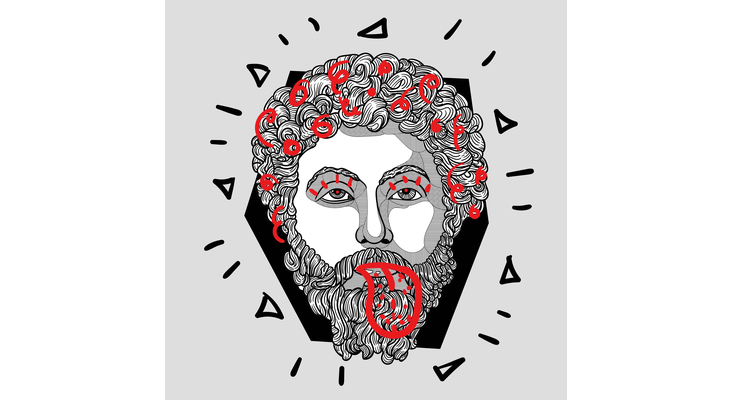In September, a writer for HBO’s Watchmen series, Cord Jefferson, was awarded an Emmy. I enjoyed the show’s first season, a sequel to arguably the best movie (and graphic novel) about superhero vigilantism. The plot involves the protagonists combatting racist violence in present-day Tulsa, Oklahoma. As Jefferson, who is Black, was accepting the Emmy, he gave thanks to friends and family and, to the surprise of many, his therapist. “Therapy should be free in this country,” he said. Not long after, in an interview with The New York Times, Jefferson expanded on his views about the importance of emotional health.1
“I think Black men are taught that stoicism is important and that in order to get along in America,” Jefferson said, “it’s important to be stoic and keep a stiff upper lip.” He noted how significant it’s been for him to discard that understanding, and to see “that stoicism isn’t a virtue,” because it’s a good thing to be sensitive to your own emotions. “That it resonated with so many people,” he said, “I think speaks to the stigma people have about therapy and mental health care and admitting you are imperfect in those ways.”
This statement is unfortunate. Jefferson is unwittingly perpetuating an inaccurate stereotype about Stoicism that prevents people from understanding a philosophy of life that has great potential to benefit them personally—and humanity more broadly. As you might guess, it comes from the same place as most stereotypes: a grain of truth that people misinterpret and play out of proportion. All the major Hellenistic philosophies have this problem. The word “skeptic” today often means someone who doesn’t believe anything. But (most of) the Skeptics in ancient Greece said to hold your opinions lightly, because human knowledge is a tricky thing. The modern English term “cynic” means someone who has an overly negative view of life and people. But the ancient Cynics were jolly fellows who decided to live simple lives, own no property, and not marry or have children. “Cynic,” in Greek, means dog-like, because the Cynics lived in the streets. In current usage, “epicurean” refers to someone who is into highly sophisticated pleasures, but the ancient Epicureans thought that the highest pleasure is the absence of mental and emotional pain.
If there is nothing you can do about a particular situation, why beat yourself up about it?
So it goes for Stoicism: The stiff-upper-lip stereotype finds its root in the fact that Stoics practice endurance. It arose in ancient Greece and Rome, established around 300 B.C. by Zeno of Citium in Athens. People spanning the social gamut practiced it, from slaves such as the early second-century Epictetus to emperors like Marcus Aurelius. They took to heart the idea that if there is nothing you can do about a particular situation, why beat yourself up about it? Work toward as serene a degree of acceptance as you can muster instead. This doesn’t mean suppressing emotions. Rather, it means shifting your emotional spectrum—away from unhealthy emotions like anger and toward the mindful embracing of healthy ones like joy—by working on consciously altering the way you think about yourself and the world.
I don’t blame Jefferson. The widespread misapprehension about Stoicism is even endorsed by a number of scholars who should know better. For instance, Edith Hall, a King’s College, London, classics scholar, wrote: “Authentic ancient Stoicism was pessimistic and grim. It denounced pleasure. It required the suppression of emotions and physical appetites.”2 And she is not alone. There is a cottage industry of papers on stoicism in psychology, built on the same stereotype.
According to a paper on pain management in cancer patients, for example, “Not acknowledging pain [like stoics do] in non-self-limiting conditions, such as cancer, can lead to negative outcomes and poor pain management and treatment.”3 Another paper on pain management, but in the context of home-care nurse-patient interactions, concurs: “Contemporary stoicism is often therefore seen to be ‘maladaptive’ in this context.”4 Other researchers are worried about “troubling stoicism,” an approach that is “characterized by silent endurance and lack of emotion—often described as a ‘stiff upper lip.’”5 More recently, in a preprint titled “Stoicism and Wellbeing,” Ronald Fischer, a behavioral scientist at Victoria University of Wellington, and his doctoral student Johannes Karl, describe the results of a study of 636 participants aimed at exploring the effects of stoicism on eudaimonic and hedonic well-being.6 Hedonic well-being refers to the experience of pleasure, while eudaimonic well-being is more concerned with meaning in one’s life.

The news ain’t good for stoicism, it seems: “We confirmed the negative effects of stoic beliefs on hedonic wellbeing observed in previous studies,” Fischer and Karl wrote. “Additionally, we found that … stoic ideology significantly negatively predicted eudaimonic wellbeing and eudaimonic wellbeing orientation, as well as engagement in life. This indicates that a naive endorsement of stoic ideology might be detrimental to individuals’ wellbeing independent of the specific aspect.”
Well, thank Zeus I’ve never been attracted by a “naive endorsement of stoic ideology.” That’s because I practice upper-case Stoicism, not lower-case stoicism. I’m into the philosophy, in other words, not the macho attitude. Not only are the two unrelated, but in fact research from practitioners of cognitive behavioral therapy shows that the philosophy promotes eudaimonic well-being as well as engagement in life. The goal of Stoicism, after all, is to make us into the best human beings we can be, and it does so through the constant applications of two cardinal principles: the dichotomy of control and the four virtues.
Epictetus in the Enchiridion (or Manual for a good life) articulates the dichotomy of control:
Some things are within our power, while others are not. Within our power are opinion, motivation, desire, aversion, and, in a word, whatever is of our own doing; not within our power are our body, our property, reputation, office, and, in a word, whatever is not of our own doing. (Enchiridion 1.1)
The concept may be familiar because it pops up in a variety of other cultural traditions, from eighth-century Buddhism to 11th-century Judaism. The Serenity Prayer that begins many meetings at 12-step organizations captures the notion in modern terms:
God, grant me the serenity to accept the things I cannot change,
courage to change the things I can,
and wisdom to know the difference.
In essence, the idea is to internalize our goals: Instead of focusing, as it comes natural, on outcomes, let’s pay attention to our intentions and efforts. The Stoics think that the only truly good thing for us is our own character, and that therefore the only truly bad things are whatever may undermine our character. Everything else (including health, wealth, reputation, etc.) has value, but does not define who we are.
Both empathy and zest for life are positively connected with Stoicism.
Suppose I have a job interview coming up. I want the job, of course. But that’s not up to me. It depends on the interviewer, their priorities and mood, as well as on my competition. What I can devote my attention to, however, is putting forth an appealing resume, preparing an argument for why I am a good candidate, dressing appropriately, and skipping any late-night drinking with friends the night before.
Of course, efforts and outcomes are correlated, but a Stoic’s self-esteem lies entirely with her efforts. We ready ourselves mentally to accept whatever outcome with equanimity. The four virtues—practical wisdom, courage, justice, and temperance—help us in this aim. They form a sort of moral compass, ethically navigating us through whatever the world throws at us. Let’s say I witness my boss harassing a coworker. Should I intervene? Practical wisdom, the knowledge of what is truly good or bad for me, tells me that I should intervene, because not doing so would undermine my character (it would be cowardly). This requires courage, because my boss might retaliate. It is also the just thing to do, if justice is understood—as it is in Stoicism—as treating other people, like my coworker, fairly and with respect. Temperance, the notion that we should do things in the right measure, neither too much nor too little, means that I can’t just mumble something inaudible under my breadth (too little), but also that I shouldn’t punch my boss on the nose (too much).
Apply the dichotomy of control and the four virtues to everything you do and, as Epictetus promises, you will never be unhappy. You will be free, and you will live a life truly worth living. We all fall short of this ideal, of course. Yet trying to live up to it really works. My friend Tim LeBon, a London-based cognitive behavioral therapist and author, has done research on this to fight back against the “stiff upper lip” understanding of Stoicism. He’s also a member of the Modern Stoicism group (to which I belong as well). These are the people who for several years have organized the annual Stoicon conference, the opportunity to live like a Stoic for a week, and a more in-depth engagement called Stoic Mindfulness and Resilience Training. Thousands of people participate every year in these activities, and Tim and his collaborators collect data on the effect of Stoicism (the philosophy) on various aspects of wellbeing.
It turns out that practicing Stoics experience a statistically significant increase in measures of their well-being, with fewer episodes of negative emotions (like anger) and more episodes of positive emotions (like joy). Moreover, such reduction of anger does not take place by way of suppression (which is impossible), but because Stoic practitioners reframe what happens to them in terms that simply do not trigger angry reactions in them. “We stop having ethically misguided and intense or conflicted emotions (sometimes called ‘passions’) and we move toward having ‘good emotions,’” as the handbook for the 2020 edition of Stoic Week states. “The passions are misguided because the passionate person supposes that happiness depends on acquiring or retaining ‘preferred indifferents,’ such as wealth or fame (rather than on exercising the virtues).” This folly leads to anger, fear, or overwhelming lust, emotions often marked “by intensity of feeling, instability and inner conflict.”
In other words, everyday sorts of anger, fear, and the like affect Stoics less because we have realigned our priorities in life toward what we think really matters: being a good person and relating positively to other human beings. Wealth, reputation, and even health we take if they come, but we can do without if they go. Of course, no matter your philosophy, no one is emotionally immune to truly life-altering events. Even so, Stoicism can help us manage something that is terrifying, tumultuous, or deeply sad.
I’m into Stoicism the philosophy, not the macho attitude.
For instance, when my mother died, a few years ago, I was mentally and emotionally ready because of my ongoing Stoic practice. This didn’t mean that I wasn’t upset when I found out her terminal diagnosis, or that I didn’t grieve for her afterward. But it did mean that I was present, completely alert to what was going on, focused on spending as much time as possible with her before she went. I was also able to handle my grief and be helpful to my family during the painful but necessary arrangements that had to be made before and after her departure.
Predictably, Stoicism is linked to the four cardinal virtues, but the data also shows that other measures of character strength—including gratitude, kindness, hope, and love—are all positively associated with Stoic practice. Finally, both empathy and zest for life are positively connected with Stoicism, with zest actually increasing after just one week of practice.7
This all amounts to a circumstantial case that Stoicism is very different from stoicism. Do we have any direct empirical evidence? Yes, we do, again thanks to Tim’s systematic efforts.8
This year’s Stoic Mindfulness and Resilience Training saw about 5,000 people enrolled. They were given two questionnaires to measure their Stoicism (the Stoic Attitudes and Behaviors Scale) as well as their stoicism (the Liverpool stoicism scale, the one used in most psychological research). The results showed a slightly negative, but in fact statistically null, correlation between Stoicism and stoicism, contrary to what the psychologists and classics scholars I mentioned above state or imply. If you practice Stoicism, you are just not inclined toward sporting a stiff upper lip.
Moreover, after a month of training as a Stoic, one’s degree of philosophical Stoicism predictably increased, while the same people’s degree of “stoicism” decreased. Practicing the philosophy actually makes it less likely that people adopt the stiff-upper-lip attitude.
You might ask why anyone should embrace a philosophy of life that is more than two millennia old. Hasn’t human understanding advanced since? I could point out that other traditions—Buddhism, Confucianism, Christianity—are also thousands of years old, and yet plenty of people find them invaluable.
But more importantly, all philosophies of life (including religions) inevitably and sometimes consciously change over time, and adapt to new socio-cultural environments. The ancient Stoic philosopher Seneca wrote:
Will I not walk in the footsteps of my predecessors? I will indeed use the ancient road—but if I find another route that is more direct and has fewer ups and downs, I will stake out that one. Those who advanced these doctrines before us are not our masters but our guides. The truth lies open to all; it has not yet been taken over. Much is left also for those yet to come. (Letters to Lucilius, 33.11)
Accordingly, modern Stoics are updating both their exercises9 and their general philosophy on the basis of the best that modern science and philosophical discourse have to offer. Stoicism’s answer to the question of how to live a good life began 24 centuries ago, but it is still very much evolving today. You may want to give it a try. No stiff upper lip required.
Massimo Pigliucci is the K.D. Irani Professor of Philosophy at the City College of New York. His academic work is in evolutionary biology, philosophy of science, the nature of pseudoscience, and the practical philosophy of Stoicism. His books include How to Be a Stoic: Using Ancient Philosophy to Live a Modern Life and Nonsense on Stilts: How to Tell Science from Bunk. His most recent book is A Field Guide to a Happy Life: 53 Brief Lessons for Living.
References
1. Parker-Pope, T. And the Emmy goes to … my therapist. The New York Times (2020).
2. Hall, E. Why read Aristotle today? Aeon (2018).
3. Hillier, R. Control of pain in terminal cancer. British Medical Bulletin 46, 279-291 (1990).
4. Spiers, J. Expressing and responding to pain and stoicism in home-care nurse-patient interactions. Scandinavian Journal of Caring Sciences 20, 293-301 (2006).
5. Moore, A., Grime, J., Campbell, P., & Richardson, J. Troubling stoicism: Sociocultural influences and applications to health and illness behavior. Health 17, 159-173 (2012).
6. Karl, J. & Fischer, R. Stoicism and wellbeing. PsyArXiv Preprints (2020). Retrieved from DOI:10.31234/osf.io/6rtny
7. LeBon, T. Stoic Week 2017 Report (part 2). Modernstoicism.com (2018).
8. LeBon, T. Report on SMRT 2020. Modernstoicism.com (2020).
9. Pigliucci, M. & Lopez, G. A Handbook for New Stoics Experiment Publishing, New York, NY (2019).
Lead image: Austin Mabe / Unsplash






























